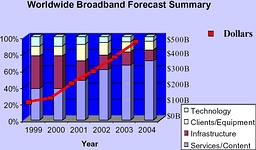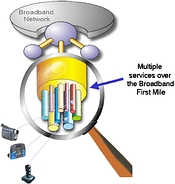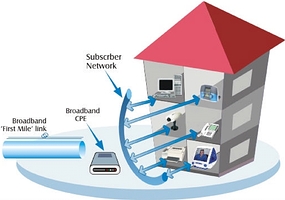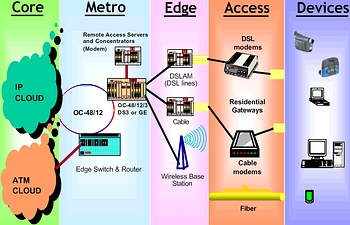
"There are clear intentions to invest, with the majority of people giving first priority to revenue-generating broadband technology and services. And there is a clear requirement for superior customer service - being able to understand what customers want - and being able to respond to those needs." Marconi CEO John Mayo, Supercomm, 2001.
Introduction
The broadband market for high-speed, continuous Internet access, which includes connections over all forms of digital subscriber line (DSL), cable modem, wireless, and fibre, is expected to grow exponentially over the next few years, from over 12 million links in 2001 to 84 million links in 2005, according to In-Stat. Broadband service providers are now positioning themselves to leverage this huge opportunity. This article analyses the broadband opportunity, highlights, related challenges and solutions, including underlying technologies, and suggests an enabling solution for marketplace success.
The move towards differentiated services
A closer look at the broadband market explains the source of projected growth. While worldwide broadband revenue is projected to increase from $90 billion in 2000 to $465 billion in 2004, the source of revenue is expected to shift dramatically from infrastructure to services and content. See Figure 1.

Of the $90 bn in broadband revenue in 2000, approximately 12% was derived from technology (eg semiconductors used in infrastructure and client equipment), 13% from client equipment (gateway devices), 40% from infrastructure (backbone equipment, switches, routers), and 35% from services and content (applications). By 2004, with a significantly larger pie of $465 bn in broadband revenue, the sources shift to 5% from technology, 10% from client equipment, 15% from infrastructure, and 70% from services and content.
It is also clear, as we pass the 100-million mark for Internet hosts, that the Internet will be the predominant network, and IP the prevailing protocol, over which these broadband services will be offered and supported.
A paradigm shift in infrastructure
To better understand the challenge that broadband service providers face in deploying and managing differentiated services, it is important to note some of the Internet's history and trends. Up until this point, specific assumptions regarding broadband content have influenced existing network infrastructure. One example is the assumption that content, including data files, video streams, and music files, predominantly flow from the service provider to the subscriber. As a result, the link that exists between the subscriber premise and the service provider's network over the Broadband First Mile is often asymmetric. Asymmetric digital subscriber line (ADSL) is a leading example of this type of link.
This assumption of asymmetric content flow is proving erroneous. We are in the midst of a major shift in bandwidth requirements as emerging applications, such as VoIP, MP3, and local mass storage, involve content that just as often originates within the subscriber premise as it does outside. This redistribution of content implies symmetry over the Broadband First Mile. In fact, as multiple-subscriber scenarios increase in prevalence, as discussed below, there will be numerous traffic flows originating in the subscriber premise, all requiring symmetric links. Service providers must find ways to support the added value of these services without imposing performance penalties.
Regardless of whether the Broadband First Mile link is symmetric or asymmetric, the bottleneck created by the connection to the WAN remains. This is particularly apparent when compared with the incredible growth of the bandwidth within the subscriber LAN. Fast Ethernet, at 100 Mbps, is becoming universal, and IEEE 802.11a wireless LAN, at 54 Mbps, is slated to replace 802.11b in 2002. While there is much press regarding the glut of broadband capacity, these LAN speeds make it clear that the broadband link to the WAN is a significant bottleneck. To compound matters, there are an increasing number of performance-sensitive services attempting to squeeze through this Broadband First Mile bottleneck. (Figure 2).

Managing differentiated services over a single link
Based on the trends described above, those service providers that want to successfully deploy differentiated broadband applications will require enabling infrastructure in a wide variety of broadband environments. These range from the residence to the small office/home office (SOHO), to the small to medium enterprise (SME). Enabling technologies will be required to support services that include, among others, Voice over IP (VoIP), MP3 downloads, e-gaming, coordination of home appliances, telecommuting, and video conferencing. Figure 3 shows an example of a subscriber network application.

In light of the wide variety of broadband environments and services, service providers must be able to back up their offerings with end-to-end quality of service (QoS) and bandwidth management, especially over the Broadband First Mile, where it is currently lacking. Service offerings must begin to include bandwidth management per application or per user over the Broadband First Mile link.
Specific network protocols, such as asynchronous transfer mode (ATM), were intended to address some of the related bandwidth management issues. However, ATM has proven costly to implement over the Broadband First Mile. Since most new services will therefore be implemented at least partially over IP, where there are few guarantees of service quality, the fact is that broadband infrastructure lags behind the market's QoS needs. Hence, the challenge to broadband service providers is to provide end-to-end IP-oriented QoS, from the core to the customer premise equipment (CPE), including over the Broadband First Mile.
Application-oriented bandwidth management
The need to support service offerings with QoS and bandwidth management capabilities has already led to the development of large application-oriented network processors designed for traffic engineering in the backbone. However, IP-oriented traffic engineering has not yet been addressed over the Broadband First Mile, primarily due to cost constraints. This constraint can be overcome. IP-oriented QoS and bandwidth management can now be deployed over the Broadband First Mile using appropriate technology in the broadband CPE, ensuring true end-to-end QoS and allowing service providers to meet the challenges outlined above.

The technology must be present within the CPE to handle the flow of traffic, manage the bandwidth, and guarantee bi-directional, end-to-end QoS, over the Broadband First Mile, all at consumer-level costs. Only by cost-effectively adding IP-oriented QoS capabilities to the CPE can service providers offer comprehensive, reliable, and attractive service solutions. Implementing robust network processing in the customer premise enables cost effective QoS. The building blocks for doing so are outlined below.
Bandwidth management building blocks
Bandwidth management and QoS within the CPE are implemented through specific network processing functions. These underlying capabilities include classification, policing, and scheduling, and form the basis of higher-level IP-oriented QoS (refer to Figure 5) In each case, the implementation of these functions must be very flexible, supporting a multitude of applications, algorithms, and capabilities. And, it must be performed with absolute minimal impact on data rate. This set of requirements is best met through a soft-hardware architecture, with primary functionality performed at wire speed in hardware, while configuration, management and exception processing are provided via software.

Classification
Classification performs packet analysis, basing realtime decisions on a pre-defined set of rules. Those rules should be dynamic, with the ability to change the rules and resulting actions during operation. As stated above, the implementation must be very flexible, supporting a multitude of classification applications. Ideally, the solution should provide deep classification covering OSI model layers 2 through 7. This allows identification of different services. Deep classification can only be provided cost-effectively through the use of hardware engines. This necessitates the soft-hardware approach where primary deep classification is performed by hardware at wire speed, while software provides flexible configuration, rule administration, and classification exception processing.
Policing
Policing ranges from simple filtering, for applications such as bridging or elementary security, to random early detection (RED), where packets are discarded based upon pre-determined rules in order to prevent network congestion. Derivatives such as balanced-RED for non-adaptive traffic, and weighted-RED for fairness and QoS should also be supported. Different policing algorithms, such as for adjusting the discard probability based upon average queue length, should be offered. Again, policing must be performed at wire speed.
Scheduling
Scheduling should support a comprehensive list of selectable algorithms, including:
* Simple fixed prioritisation
* Weighted Fair Queue (WFQ)
* Worst-case Fair Weighted Fair Queue (WF2Q & WF2Q+)
* Round Robin (RR)
* Weighted Round Robin (WRR)
* Deficit Round Robin (DRR)
* Class Based Queuing (CBQ)
* Delay sensitive scheduling (for voice and video)
Strict priority algorithms, such as simple fixed prioritisation, transfer all the contents of the highest priority queue first, and then transfer all the contents of the next highest priority queue. The size of the queue is not taken into consideration. WFQ algorithms attempt to approximate the bit-by-bit Round Robin model. After a packet is transferred, the algorithm recalculates the virtual finish time of all queued packets and transfers the packet with the lowest virtual finish time. WFQ schedulers attempt to ensure that packets do not exceed a maximum wait delay. This is useful for delay-sensitive applications, such as video and voice.
Round Robin algorithms attempt to distribute bandwidth among the queues with transmission of packets, in sequential order, from each queue. Weighted Round Robin (WRR) algorithms take packet size into consideration and enable the transfer of more than one packet at a time. Deficit Round Robin (DRR) algorithms compensate for overweight transmission on the subsequent round.
Class-based queuing algorithms work by collecting common packet types across the hierarchy and providing the group with an overall transmission bandwidth. Ideally, scheduling should be flexible enough to support custom applications and, of course, should be performed at wire speed.
Conclusion
Broadband service providers will increasingly find themselves competing in their ability to support differentiated service offerings with IP-oriented QoS and bandwidth management throughout their network. This is especially true over the Broadband First Mile, originating within the CPE, where IP is the predominant networking protocol. Single system-on-chip (SoC) solutions that are affordable and are capable of supporting the required network processing functionality are now emerging. They solve the challenge through a soft-hardware approach where primary network processing is performed in hardware at wire speed, while flexible configuration, management, and exception processing are provided in software. These enhanced network processors support IP-oriented QoS at a price-performance suited for the CPE, and promise to enable the explosion of next generation broadband services.
One example of this type of solution is Redux Communications' AccessGate, a cost-effective, high-performance network processor for broadband IP services optimised for use within the subscriber premises. The AccessGate meets the bandwidth management and QoS challenge by providing IP application-oriented classification, policing, and scheduling, all at wire-speed of up to 100 Mbps.
Terms
ADSL Asymmetric Digital Subscriber Line
ATM Asynchronous Transfer Mode
CBQ Class Based Queuing scheduling algorithm
CPE Customer Premise Equipment
DRR Deficit Round Robin scheduling algorithm
DSL Digital Subscriber Line
IP Internet Protocol
LAN Local Area Network
MDU Multi-Dwelling Unit
MTU Multi-Tenant Unit
OSI Open Systems Interconnection
RED Random Early Detection
RR Round Robin scheduling algorithm
SME Small to Medium Enterprise
SoC System on Chip
SOHO Small Office/Home Office
VoIP Voice over IP
WFQ Weighted Fair Queue scheduling algorithm
WF2Q Worst-case Fair weighted Fair Queue scheduling algorithm
WRR Weighted Round Robin scheduling algorithm
© Technews Publishing (Pty) Ltd | All Rights Reserved